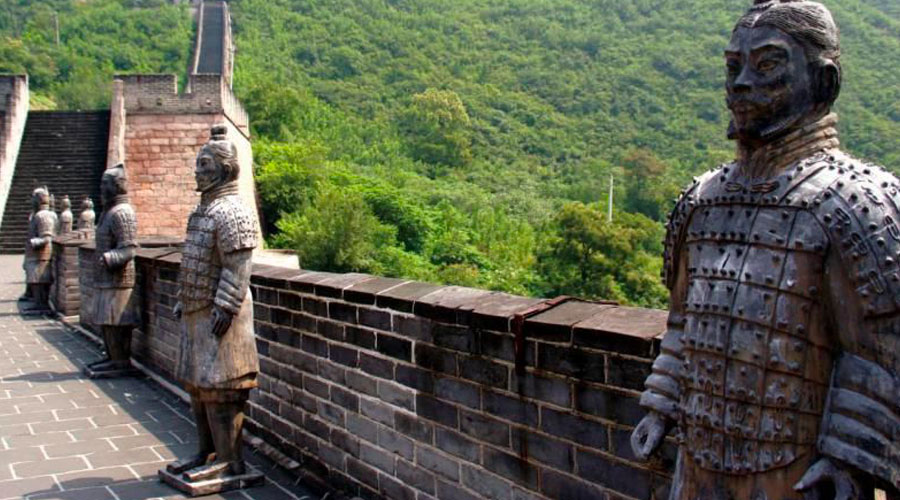A proud and sinuous dragon: the Great Wall from a bulwark of defense to a symbol of cultural identity
Mao Zedong once said: "You are not a true hero if you don’t climb the Great Wall"
With this motto, which later became famous, he intended to emphasize that true greatness as well as success and full realization can only be reached after facing great difficulties. Metaphors aside, in the words of the Chinese captain is enclosed all the meaning that covers and that has covered this imposing and majestic architectural work for China. Counted among the Seven Wonders of the world and now a UNESCO heritage site, the Great Wall is an absolute icon, a symbol of unification, separation and attraction at the same time. Better known, in silky land, with the name of Wan li chang cheng, Long wall of ten thousand Lì, was built over 2000 years ago and still preserves the signs of the various dynasties, which have left traces of themselves and of their greatness on walls, lookout towers and fortresses. Like a proud and sinuous dragon, the wall winds for almost 22,000 kilometers along deserts, plains and mountains, stretching from Hushan to the northeast, to Beijing, and then continuing to Inner Mongolia and the Jiayuguan Pass in the province of Gansu.

The foundation stone for the construction of this cyclopic work was laid around the 7th century BC, when China was still divided into many small states, so it was built with a mainly defensive purpose. It was then with the first emperor of the Qin dynasty and then with the territorial unification that the fortifications were connected together, this time to defend themselves from the people of the North and to protect the Silk Road. The Great Wall was therefore born as a bulwark of defense, to then mark the passage from barbarism to civilization, finally it became a symbol of union and cultural identity. It is today one of the most visited sites in the world, for its beauty, grandeur and absolute uniqueness and is therefore an obligatory stop for those who venture to discover China and its wonders. Most of the sections and even the most famous and most beautiful to visit are located around the Beijing area and are easily accessible. The wall in fact is not uniform and monotonous, but each section is different from another, each is linked to a dynasty, has its own characteristics and its own story to tell. And there are dozens of stories and legends that hover around this majestic building, born of myth and reality, charm and mystery. Historians in fact hand down that the great wall was the fruit of labor, blood and the sweat of the people, which inspired a series of stories that later became the emblem of the wall, they became part of the culture and national identity , just like the story I'm about to tell you.
At the time of the Qin dynasty, a young woman named Meng Jiangnü decided to help a man named Fan Xiliang to escape the emperor's guards who were recruiting a labor force for the construction of the Great Wall. The two soon fell in love and decided to marry, but three days later the happy event, Fan was captured by the guards and forced to serve in northern China. A year passed without Fan was able to return home or bring his news, so his wife decided to visit him and bring him warm clothes. Shee climbed the mountains, crossed the rivers and faced the cold winter, animated only by the desire to embrace her beloved bridegroom. But once she reached the foot of the wall, the tragic news fell on her, her husband died, struck by fatigue, and was buried, along with many others, among the bricks and fortifications, swallowed by the cruel wall.
Meng Jiangnü cried for three days and three nights without stopping, when suddenly she heard a loud noise coming from the walls. Legend has it that the wall, touched by so much torment, crumbled, showing the body of the deceased husband, who was granted a worthy funeral rite. As for the young widow, she was asked to marry the emperor and to escape from the marriage and be reunited with her beloved, she threw herself into the ocean, near the Bohai Sea. To commemorate the story of Meng Jiangnü and to not forget the hard work and sacrifices of the population, a temple was built in his honor at the foot of the Great Wall in the city of Qinhuangdao, Hebei during the Song dynasty. The temple is still visible and can be visited, an emblem of imperial grandeur but at the same time a symbol of the sacrifice that is the basis of all great enterprises. The phrase of Mao Zedong returns now, clearer and ever more current, "you are not a true hero if you don’t climb the Great Wall". This is perhaps the most beautiful warning ever, especially for the new generations, because what heroism is if not to go beyond its own limits, its borders, have the courage to dare and to pursue one's dreams. The mantra therefore, today as then, is that of daring, breaking barriers and fighting for one's own ideas. Enjoying the view from above is priceless!

